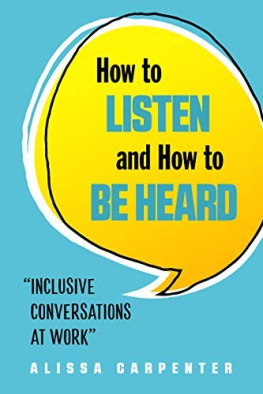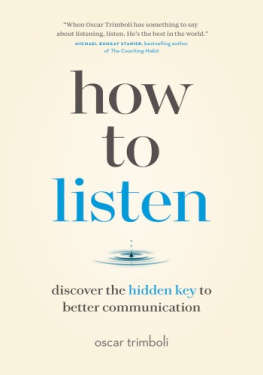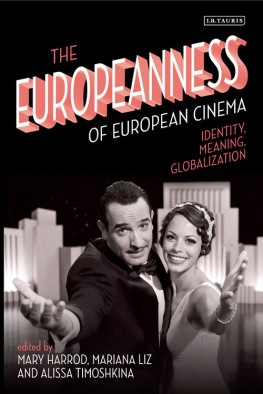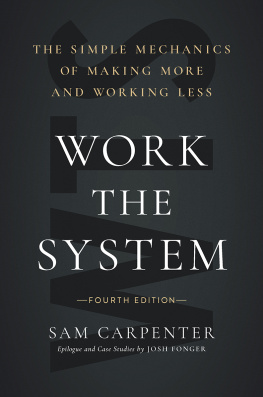Alissa Carpenter - How to listen and how to be heard : inclusive conversations at work
Here you can read online Alissa Carpenter - How to listen and how to be heard : inclusive conversations at work full text of the book (entire story) in english for free. Download pdf and epub, get meaning, cover and reviews about this ebook. year: 2020, publisher: Red Wheel Weiser, genre: Home and family. Description of the work, (preface) as well as reviews are available. Best literature library LitArk.com created for fans of good reading and offers a wide selection of genres:
Romance novel
Science fiction
Adventure
Detective
Science
History
Home and family
Prose
Art
Politics
Computer
Non-fiction
Religion
Business
Children
Humor
Choose a favorite category and find really read worthwhile books. Enjoy immersion in the world of imagination, feel the emotions of the characters or learn something new for yourself, make an fascinating discovery.
- Book:How to listen and how to be heard : inclusive conversations at work
- Author:
- Publisher:Red Wheel Weiser
- Genre:
- Year:2020
- Rating:4 / 5
- Favourites:Add to favourites
- Your mark:
- 80
- 1
- 2
- 3
- 4
- 5
How to listen and how to be heard : inclusive conversations at work: summary, description and annotation
We offer to read an annotation, description, summary or preface (depends on what the author of the book "How to listen and how to be heard : inclusive conversations at work" wrote himself). If you haven't found the necessary information about the book — write in the comments, we will try to find it.
How to listen and how to be heard : inclusive conversations at work — read online for free the complete book (whole text) full work
Below is the text of the book, divided by pages. System saving the place of the last page read, allows you to conveniently read the book "How to listen and how to be heard : inclusive conversations at work" online for free, without having to search again every time where you left off. Put a bookmark, and you can go to the page where you finished reading at any time.
Font size:
Interval:
Bookmark:
HOW TO LISTEN AND HOW TO BE HEARD This must-read book teaches you an approach to handling difficult conversations and offers a roadmap to bring people together for more productive, human connections.DEIRDRE BREAKENRIDGE, author, speaker, and CEO at Pure Performance CommunicationsIf you want to become a more effective communicator, follow Alissa's valuable advice in How to Listen and How to Be Heard . You won't regret the conversation that happens afterwards.LAURA VANDERKAM, author of Off the Clock and Juliet's School of Possibilities How to LISTEN and How to BE HEARD INCLUSIVE CONVERSATIONS AT WORK ALISSA CARPENTER
This edition first published in 2020 by Career Press, an imprint of
Red Wheel/Weiser, LLC
With offices at:
65 Parker Street, Suite 7
Newburyport, MA 01950
www.careerpress.com
www.redwheelweiser.com
Copyright 2020 by Alissa Carpenter
All rights reserved. No part of this publication may be reproduced or transmitted in any form or by any means, electronic or mechanical, including photocopying, recording, or by any information storage and retrieval system, without permission in writing from Red Wheel/Weiser, LLC . Reviewers may quote brief passages.
ISBN: 978-1-63265-163-1
Library of Congress Cataloging-in-Publication Data available upon request.
Cover design by Kathryn Sky-Peck
Interior images by Kenny Halsey
Interior by Maureen Forys, Happenstance Type-O-Rama
Typeset in Minion Pro and Auster Rounded with RB No 2.1 and Argyle Socks
Printed in Canada
MAR
10 9 8 7 6 5 4 3 2 1
www.redwheelweiser.com/newsletter
TO BRiAN, AVERY, AND XAViER CONTENTS ACKNOWLEDGMENTS WRITING A BOOK is never a simple or easy task. In order to get this one into your hands, I had a lot of behind-the-scenes help.I'd first like to thank John McAdam, who suggested that I write this and helped come up with a rough outline, and Colleen Heavens, who was instrumental in fleshing out those ideas. I'd also like to thank Steve Harris, my literary agent, for believing in this project and bringing it to life.Many thanks to the subject matter experts who shared their personal stories: Heather Z. Kay, Dr. Scott J. Romeika, Dr. Katherine La Hart, John Herbut, Due Quach, Dr. Janice Asare, Dr. Hoi Ning Ngai, Greg DeShields, Red Coffey, Drew Albert, C. Coffey, Judy M., Celia C., Juan Vasquez, Debbie Roman, Jamie Librot, Taylor D., Karen Swanson, Kristen Topping, Lori Rosenthal, Amy Gallagher, Gary Miciunas, Dr. Amy Cooper Hakim, Christina Merriweather, Rev. Charles Howard PhD, Winne Sun, Jennifer Sherlock, Nicole Stephenson, Brian Coll, Chantel Soumis, Rhona Fromm, Briana Lora, Barbara Taylor, Eleanor Lyons, Darla Still, and the others who wished to remain anonymous.This book would not have been possible without my parents and in-laws (Mom, Dad, Mark, Hali, Lynne, and Richard) who have always supported me, no matter how out there my ideas have seemed. My brother Mathew also deserves my thanks for his service to our country, for showing me what true resilience and grit look like. My circle of friends and family has also been behind me all the way through this process. They supported me when I took the great leap of opening my own business and have continued to support me as I work my way through the book-writing process.I also want to thank all the readers for taking the time to read and share this book. This project would not have been possible had it not been for their continued encouragement, social media promotion, referrals, and interest. Thank you for the support and for making an active effort to humanize our workplaces one conversation at a time.And finally, my kids and husband (Avery, Xavier, and Brian) have been everything to me throughout this process. Their sacrifices and support have meant the world to me. The three of them have inspired my creativity, provided endless supplies of Swedish Fish, and have been my consistent reminder of why I do what I do. I love you. INTRODUCTION ACCORDING TO GALLUP'S State of the American Workplace report, only 30 percent of employees strongly agree that their opinions count at work. Yes, only 30 percent. So, what does that mean for the other 70 percent? Well, they're likely feeling unheard, unseen, and not understood. Remember the last time someone didn't listen to something you felt was important? When they completely shot down your idea or just ignored it? I'm sure it felt pretty crappyin all of its Why am I even in this meeting? glory.But why is this the case? What's causing this feeling among so many employees throughout the workplace?First let's look at how different today's modern workforce really is. Right now, five generations are out there working together, ranging in age from 16 to over 75. And within these generations, more and more diversity has entered the mix. No matter whether you are looking at gender, race, ethnicity, or religion, the workplace doesn't look like it did 50 years ago (or even 10 or 20).And then mixed in with those differences in age, culture, and whatever else, we have all sorts of different personalities! Who we are and how we think is made up of all of the experiences we've had in our lives up until this point. Each individual brings their own way of seeing things and expressing them into their careers (and around that conference room table). No two peopleeven if they share similar backgrounds or demographicshave the same perspective.OK, so after reviewing all of this, it's pretty clear that we have many differences cropping up in the workplace. And it's pretty safe to say that these contribute to why so many employees are having trouble getting through to their colleagues and bosses. So, what do we do about it?The first step is to recognize that these differences exist, and that they're here to stay. We need to respect and embrace our varied viewpoints, and then we can start to communicate across (not against) them. We need to accept these differences as a natural part of working with others and we need to start actually listening to each other. Open your ears to what others have to say. Open your mind to different ideas and ways of thinking. Agree that you're likely to always disagree on some things. But make it a point to at least start talking about what these things are.This book provides hands-on tools to help you start and guide these important conversations. It covers mediums and phrases to use. Strategies to enact. Physical spaces to build and transform. It explains how taking a novel approachfor something big, or something smallcan ultimately create the opportunity for new dialogue that gets you moving forward.We'll talk about how we can break down communication barriers in our modern work environments and how this is just as important in our digital spaces as it is in person (or maybe even more so). We'll cover important questions: How do we connect with our virtual coworkers via technology? How do we navigate change as leaders and as employees? When should we take a conversation out of an email, and into someone's office?Other chapters talk about how we can make ourselves accessible to build relationships; why it's important to be transparent and always put all of our cards on the table; and how to say no while still fostering a culture of openness and creativity. We'll get into tackling challenges like departmental divides, the silo effect, and toxic coworkers.And we'll also talk about some crucialand sometimes hard-to-havediscussions that need to start happening. How do we openly talk about diversity, inclusion, and belonging? How do we get out of our comfort zones and start genuinely trying to understand where people are coming from? How do we make our workplaces more... human?Ultimately, I hope you use the tools in this book to develop stronger teams that are built on trust and authentic communication. This doesn't mean everyone will be best friends or high-fiving across cubicles. But it will mean respect, clarity, and directnessall made possible with more productive communication.The majority of the advice in this book applies to both managers and non-managers and can be used by employees at all levels of an organization. If you are a manager, use your influence to implement these strategies and make your teams better. If you're not a manager and read about an idea that would make sense in your organization, bring it up to your supervisor. Let's not think in terms of us versus them. We're all in this together.Remember, though, there are no quick fixes. Working toward change takes time. It takes conscious effort. This book is a good start for getting everyone on the same page, or at least in the same room, but I would be doing you a disservice if I said it answers any and all questions about working in diverse workplaces. People and environments are constantly changing and evolving, and each individual coworker or supervisor is always a person all their own. You should mold and adapt the strategies you find in the pages that follow, including the Human Connections I've included from other content experts, to your own particular situations and relationships.But also remember this: Every employee within an organization can provide value. Every. Single. One. Everyone is in a position of power to bring change to their role, to their unit, and to the overall success of an organization. What makes you different is what makes you great. So, learn to appreciate these differences in your colleagues, and understand how these things might impact how they think, act, or feel in the workplace. Doing so might be hard or uncomfortable, but invest in getting there. One conversation at a time.To continue learning, head to www.notokthatsokcoach.com/book for additional resources and videos. PART I The Advantages of Our Differences CHAPTER 1 Putting Our Strengths into Action THE BEST EMPLOYEES bring something to the table that no one else can. But sometimes these talents and strengths are overlooked, underutilized, or even mistaken for weaknesses. When we don't know each other's strengths, we're not maximizing the effectiveness of the conversations we can have, and we're not making efficient use of our talent resources. Taking the time to uncover each of our strengths helps us understand why people communicate in certain ways and what information they need to make decisions. Doing so also provides us with insight into how we can adjust our own communication styles to be more effective, and it helps us get to the bottom of why we seem to butt heads with certain people, while having better synergy with others.While at work, have you ever encountered these scenarios?Next pageFont size:
Interval:
Bookmark:
Similar books «How to listen and how to be heard : inclusive conversations at work»
Look at similar books to How to listen and how to be heard : inclusive conversations at work. We have selected literature similar in name and meaning in the hope of providing readers with more options to find new, interesting, not yet read works.
Discussion, reviews of the book How to listen and how to be heard : inclusive conversations at work and just readers' own opinions. Leave your comments, write what you think about the work, its meaning or the main characters. Specify what exactly you liked and what you didn't like, and why you think so.












